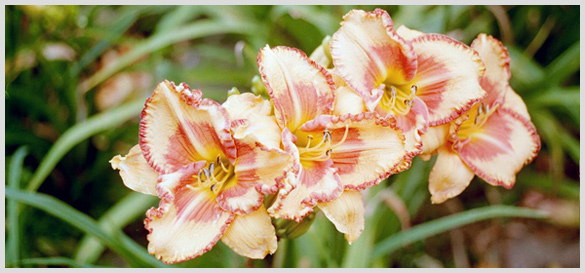All about daylillies
By Lynette Walther
By Lynette L. Walther
 A rainbow of colors, sizes and even ruffles can be found in daylily blossoms.
A rainbow of colors, sizes and even ruffles can be found in daylily blossoms.
These hardy perennials deserve to be in every garden. photo by Lynette L. Walther
For Susan Shaw of Camden, it was love at first sight when she was bitten by the daylily bug, and she has been growing and hybridizing daylilies for years. She loves the long-lasting color they add to her gardens. She loves that they are non-fussy perennials that thrive with minimal care (see sidebar). She loves to snack on their crisp-tender flower petals. (The fragrant varieties are the sweetest.) She even loves the strappy green foliage of the plants when they aren‚t in bloom. But most of all she loves to create new color and bloom combinations through hybridization.
 photo by Lynette L. Walther
photo by Lynette L. Walther
“It’s really fun. I love the hybridizing,” said Shaw, who hosts annual open garden days at her place in late July and early August, generally from 8:30 a.m. to 1:00 p.m. each day at her own little “experiment station” on Mill Street in Camden. Call 207-236-4085 for details.
Shaw has created and registered several new varieties. She said she favors daylilies that are especially winter hardy, and those with a long season of bloom. She added that the dormant daylily varieties are most often recommended as hardiest for this area, but she has had great success with a few evergreen types.
“I try to do low-care maintenance. I want to hybridize for something that doesn’t need coddling,” she said.
 Susan Shaw
Susan Shaw
photo by Jamie BloomquistDaylilies (Hemerocallis) are found growing wild from the far north to the deep south. Although today’s hybrids can be traced back to those hardy roadside plants, modern daylilies are quite different in looks and growth habits. A life member of the American Hemerocallis Society, Shaw said most daylily hybridization has been conducted over the past 60 years. The society puts her in touch with people from all over who work with daylilies.
Hybridizers must be a patient lot, because it takes about two years to get from seed to flowering new variety. Lush colors, frilled petals, and multiple dramatic blooms are all part of many of those gorgeous new daylilies.
“I’ve been hybridizing seriously for seven years, and it is so exciting to see what will bloom,” Shaw said, adding that she has probably amassed some 600 varieties. “I have too many, and I’m going to be thinning out. I really can’t keep every daylily, but if I had about five acres I would grow them all,” she enthused.
For more information on Susan Shaw’s open garden days, call her at 207-236-4085.

 A rainbow of colors, sizes and even ruffles can be found in daylily blossoms.
A rainbow of colors, sizes and even ruffles can be found in daylily blossoms. These hardy perennials deserve to be in every garden. photo by Lynette L. Walther
 photo by Lynette L. Walther
photo by Lynette L. Walther Susan Shaw
Susan Shawphoto by Jamie Bloomquist
| Growing daylilies is easy. Daylilies will survive under many adverse conditions, but to have thriving daylilies that bloom often, try these simple tips for daylily success. Provide your daylilies with: * Full sun. (Some varieties will do well with part afternoon shade.) * Good soil. (Daylilies love well-rotted horse manure.) * Enough water. (Some varieties are suitable for wet sites, but generally they like good drainage.) |

Contributing Garden Editor Lynette L. Walther is the recipient of the National Garden Bureau’s Exemplary Journalism Award and the IABC Silver Quill Award of Excellence. She is a member of the Garden Writers Association. She gardens in Camden.
Related Articles
Share this article:
2023 Maine Boat & Home Show

Join Us for the Maine Boat & Home Show!
Art, Artisans, Food, Fun & Boats, Boats, Boats
August 11 - 13, 2023 | On the waterfront, Rockland, Maine
Click here to pre-order your tickets.
Show is produced by Maine Boats, Homes & Harbors magazine.















